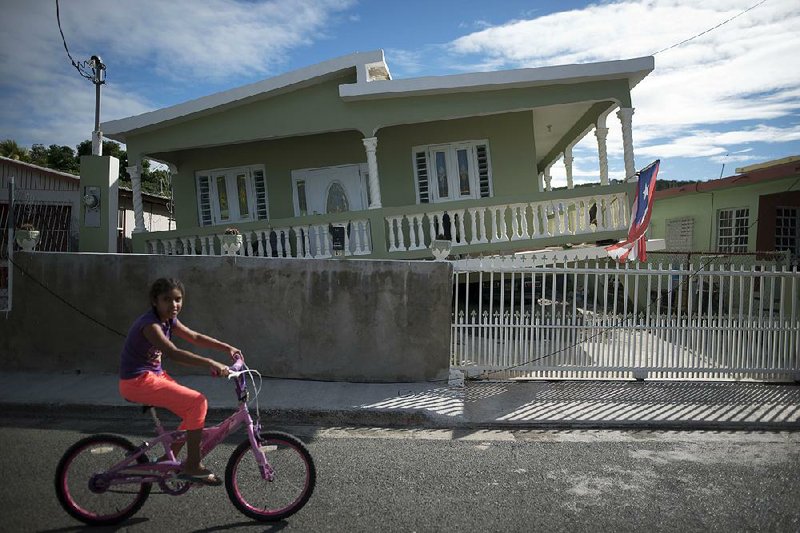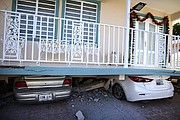GUANICA, Puerto Rico -- A 5.8-magnitude quake hit Puerto Rico before dawn Monday, unleashing small landslides, causing power failures and severely cracking some homes. It was one of the strongest quakes yet to hit the U.S. territory that has been shaking for the past week.
There were no immediate reports of casualties.
The quake was followed by a string of smaller temblors, including another quake measured at magnitude 5 that struck later Monday, at 10:51 a.m. there, shaking power lines and frightening residents of southern Puerto Rico who had been waiting outside their homes due to fears the buildings were damaged and unstable.
The first quake struck at 6:32 a.m. just south of the island at a relatively shallow depth of 6 miles, according to the U.S. Geological Survey. There was no tsunami threat, officials said.
In the southern town of Guanica, Mayor Santos Seda said five homes collapsed, but only one of them was inhabited. No injuries had been reported.
Another 29 homes were heavily damaged, he said.
Helicopters buzzed overhead and terrified residents jumped up from their folding chairs every time the earth shook, yelling at others to stay away from power lines.
[Video not showing up above? Click here to watch » https://www.youtube.com/watch?v=Z_yae1sCP3g]
Few people dared go back inside their homes, but Jose Quinones, 54, had no choice. His 80-year-old mother had heart problems and was lying in bed.
Dozens of people in a neighborhood called Hope in Guanica walked around with their phones and yelled out the magnitude of the latest earthquakes as they tried to calm children who were forced to open their presents on Three Kings Day, a religious holiday, on streets and sidewalks.
"This is hell," said Alberto Rodriguez, 43, whose home collapsed on its side as the smell of gas filled the air. "We haven't slept... you can't remain calm here. Guanica is no longer a safe place."
Less than a block away, Silvestre Alicea surveyed his home, the foundation of which collapsed on his bright blue 1977 Toyota Corolla, a prized possession.
He jumped from his balcony as the home collapsed.
Alicea had lived in New York for years until he retired to Guanica two years ago to live in the home he spent 15 years building. He doesn't have insurance.
In the working class neighborhood, people shared soda and snacks as they sought shelter from a harsh sun, careful to stay away from homes where columns and foundations were heavily cracked.
Many already had bags packed in their cars with a change of clothes, food, water and medicine.
Some like Noelia De Jesus, 69, and her husband, who uses a wheelchair, didn't know where they would spend the night. Government officials who inspected their home earlier in the morning said it was unsafe to live in and advised them to stay elsewhere.
"Everything broke, including the TV," she said. "This is horrible."
[Gallery not loading above? Click here for more photos » arkansasonline.com/17puertorico/]
Puerto Rico doesn't have a public earthquake warning system, except for sirens that are supposed to ring in case of a tsunami. Residents in the neighborhood criticized the government for what they believe is a lack of action.
Dr. Sindia Alvarado, who lives in the southern coastal town of Penuelas, said she was petrified.
"My entire family woke up screaming," she said. "I thought the house was going to crack in half."
The flurry of quakes in Puerto Rico's southern region began the night of Dec. 28, with quakes ranging in magnitude from 4.7 to 5.1. Previous quakes of lesser magnitudes in recent days have cracked homes and led to goods falling off supermarket shelves.
Victor Huerfano, director of Puerto Rico's Seismic Network, said shallow quakes were occurring along three faults in Puerto Rico's southwest region: Lajas Valley, Montalva Point and the Guayanilla Canyon. He said the quakes overall come as the North American plate and the Caribbean plate squeezes Puerto Rico, and that it was unclear when they would stop or if bigger quakes would occur.
One of the largest and most damaging earthquakes to hit Puerto Rico occurred in October 1918, when a 7.3-magnitude quake struck near the island's northwest coast, unleashing a tsunami and killing 116 people.
A Section on 01/07/2020


